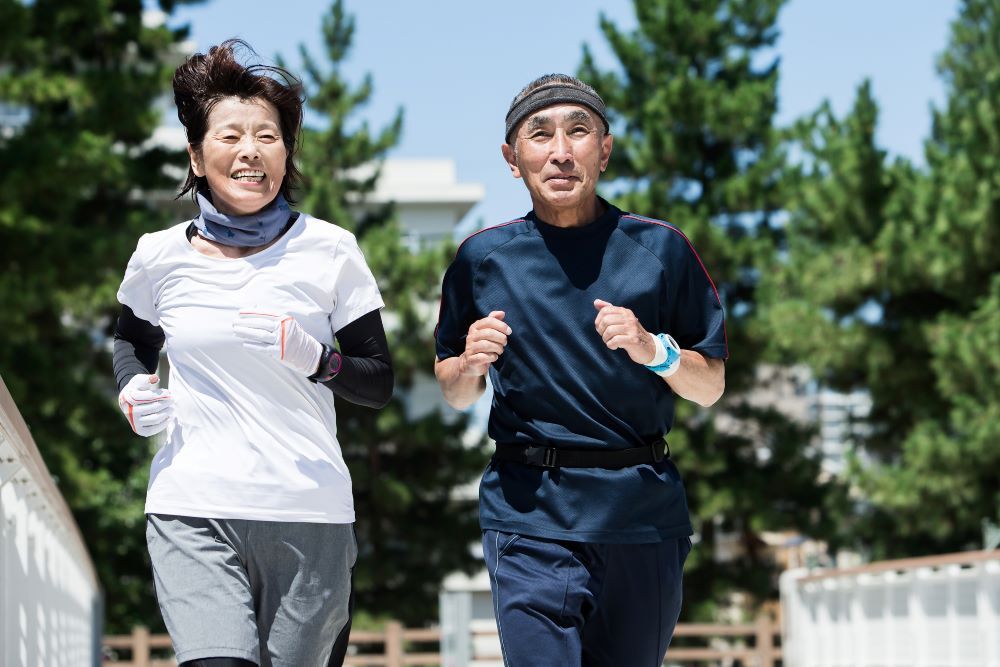|
This Q&A dives into longevity science and the science of aging in a very practical way. In addition to explaining the role of exercise in aging and providing tips for motivating and empowering clients through conversations about this trending topic, we explore exactly what types of exercise will have the biggest impact on a client’s longevity. In addition, we discuss the concept of lifespan vs. healthspan and how exercise can impact what matters most.
Read on for expert insights into ways that you can deliver an empowering message and provide exercise programming that will directly affect the long-term health and well-being of your clients.
|
Jan Schroeder, PhD, is a professor in the Department of Kinesiology at Long Beach State University and the coordinator of the Bachelor of Science degree in Fitness. Dr. Schroeder is also the owner of Garage Girls Fitness, an in-person and online training company that focuses on group exercise, as well as health and wellness education for women.
Can you tell me a little bit about the type of work you do as both an academic and an exercise professional?
As a professor, I work with students who are interested in careers within the fitness industry and oversee internships. I teach classes such as Theory and Analysis of Group Exercise Instruction; Fitness and the Aging Process; and Fitness Management. I also conduct research on programming trends within fitness. As an exercise professional, I work with women who are going through, or have transitioned through, menopause. We focus on activities that will prevent strength and bone loss, reduce the risk of heart disease and improve their fall risk index. We also focus on building a support system within our group. Most of my clients have been with me for 15+ years.
Longevity has become a bit of a buzzword in social media and marketing, but it’s often used in confusing and even contradictory ways. How do you think longevity is best defined?
By strict definition, longevity is the length of the lifespan independent of the biological aging process, or another way to state it is how many years someone has been alive. However, the term longevity is now being used as the ability to live a long, healthy life, where both lifespan (the number of years lived) and healthspan (the number of years lived in good health) are maximized. This definition emphasizes not only the length of life but also the quality of life during those years. As a fitness professional, I am more concerned about how an individual is biologically aging than their chronological age. My clients are concerned with being able to live independently and continue activities that they have enjoyed throughout their lifetime. They are truly less concerned with living longer than they are with being able to play with their grandchildren or to play pickleball without the worry of injury. So, my goal is to extend the period of life during which individuals are healthy, active and capable of enjoying their lives to the fullest.
How do you think health coaches and exercise professionals can talk to their clients about longevity so that things like reducing health risks and avoiding injury become positive motivators rather than something that induces fear?
There are definitely ways for health coaches and exercise professionals to frame conversations about longevity in a way that emphasizes the positive outcomes of healthy habits rather than inducing fear. They should highlight how exercise and healthy lifestyle choices empower clients to live fuller, more independent lives as they age. Instead of emphasizing the fear of illness or injury, talk about how staying active increases energy, improves mood and enhances daily living.
When working with my clients, we celebrate the small wins. I reinforce the immediate benefits of physical activity, like better sleep, reduced stress and increased mobility. Celebrating these small wins helps clients feel encouraged and recognizes that their efforts today contribute to long-term health. I also like to connect the concept of longevity to individual goals. If a client enjoys playing with their grandchildren or has a passion for travel, frame exercise as a way to keep doing what they love for years to come. Making it personal fosters motivation and helps them see the positive impact on their own life.
It is critical to use positive, proactive language like “building strength” or “gaining energy” rather than focusing on avoiding risks or diseases. This helps shift the mindset from a fear-based motivation to one that’s centered on growth, improvement and vitality. I feel it is also critical to educate our clients. For example, when discussing injury prevention, focus on how proper exercise can improve balance, coordination and flexibility, which leads to more confidence and independence in everyday activities. It’s about being proactive in maintaining strength and mobility.
Also, share success stories of clients who’ve improved their quality of life and extended their healthspan through physical activity. These real-life examples offer inspiration and make the long-term benefits more relatable. By keeping the tone positive and emphasizing the tangible, everyday benefits of physical activity, coaches and exercise professionals can motivate clients toward longevity without fear.
This may be a broad topic, but how do physical activity and exercise directly impact longevity?
Definitely a broad topic. It has been found that physical activity and exercise can increase the lifespan by an average of three years (for males) or four years (for females). But once again, I find it more important to focus on the benefits of physical activity and exercise to improve the quality of life.
Regular exercise impacts longevity in a number of ways. It strengthens the heart muscle, improves circulation and helps lower blood pressure and cholesterol levels, thereby reducing the risk of heart disease and stroke. Weight-bearing exercises and resistance training help build and maintain muscle mass and bone density, reducing the risk of osteoporosis and frailty with age. Physical activity releases endorphins, improving mood and reducing stress, anxiety and depression. It also enhances cognitive function and may reduce the risk of dementia and cognitive decline. Regular exercise boosts the immune system, reducing the risk of chronic illnesses and infections. Staying physically active promotes independence and enhances overall quality of life as we age, enabling individuals to maintain mobility and perform daily activities.
Overall, integrating regular physical activity and exercise into daily life is crucial for promoting longevity and reducing the risk of chronic diseases associated with aging.
Are there certain types of exercises or workouts people should perform if longevity is a primary concern?
Yes, certain types of exercises are particularly effective for promoting longevity by improving overall health and mobility and reducing the risk of chronic diseases. The key is to focus on a balanced exercise routine that includes the following:
-
Cardiorespiratory exercise: The benefits of cardio include improving cardiovascular health, improving lung capacity and reducing the risk of heart disease, stroke, diabetes and obesity. The recommendation is 150 to 300 minutes of moderate aerobic activity or 75 to 150 minutes of vigorous activity per week. Brisk walking is especially linked to a longer life expectancy.
-
Resistance training (including power training): This type of training increases muscle mass, improves bone density, reduces the risk of osteoporosis, supports metabolic health and maintains independence as we age. This type of training should be a main focus of your exercise program. The recommendation is two or more days per week, targeting all major muscle groups.
-
Flexibility and mobility training: This type of training helps to maintain joint health, improves posture, increases range of motion, reduces the risk of injury and helps alleviate pain. The recommendation is a minimum of two or three days per week.
-
Balance training: Balance training reduces the risk of falls, which can reduce the risk of injury and enhance independence in older adults. The recommendation is at least two or three days per week, especially for those 65 and older.
Focusing on a combination of these exercise types can contribute significantly to both physical and mental health as we age, helping increase life expectancy and improving quality of life.
Finally, is there anything else you’d like to highlight about this topic and what it means to health coaches and exercise professionals?
I think the biggest thing to emphasize is that we need to work with our clients on improving their quality of life and worry less about extending their life.
To learn more from Dr. Schroeder and other experts on the topic of longevity, register now for the ACE Health and Fitness Summit: Achieving Longevity through Movement (worth 0.5 ACE CECs). This FREE event takes place on November 8, 2024, from 8:00 a.m. to 4:00 p.m. PST. The day will begin with a panel discussion on the role of exercise in healthspan and longevity and feature four additional sessions covering everything from Pilates to wearables and how they can impact longevity.


